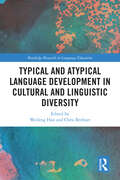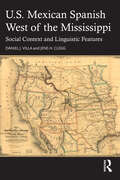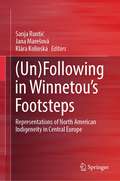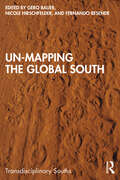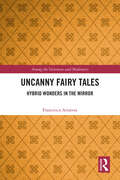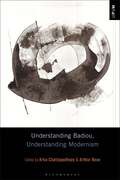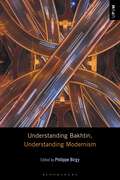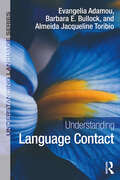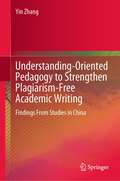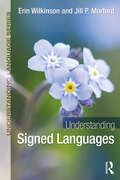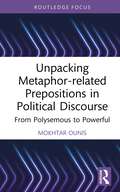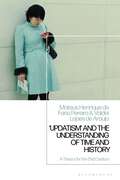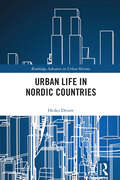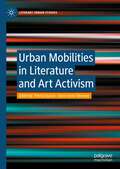- Table View
- List View
Typical and Atypical Language Development in Cultural and Linguistic Diversity (Routledge Research in Language Education)
Typical and Atypical Language Development in Cultural and Linguistic Diversity brings together state-of-the-art studies in both typical and atypical language development. Placing the topic in the context of cultural and linguistic diversity (CALD), the book offers readers serious theoretical consideration of the topic and provides implications for multilingual educational and clinical practices. The content covers a wide range of topics related to multilingual language development in CALD: typical and atypical language development in CALD, and the interface between both; the relationship between multilingual competence and academic performance in CALD; providing unbiased speech and language measures in CALD; and heritage and minority languages education in CALD. Each chapter outlines the core theoretical and practical issues and explores both theoretical and pedagogical/clinical implications in the area and possible future developments. This volume is an essential resource for all those who study, research, or are interested in multilingual development, educational linguistics, and clinical linguistics in the CALD context.
Typical and Atypical Language Development in Cultural and Linguistic Diversity (Routledge Research in Language Education)
by Weifeng Han and Chris BrebnerTypical and Atypical Language Development in Cultural and Linguistic Diversity brings together state-of-the-art studies in both typical and atypical language development. Placing the topic in the context of cultural and linguistic diversity (CALD), the book offers readers serious theoretical consideration of the topic and provides implications for multilingual educational and clinical practices. The content covers a wide range of topics related to multilingual language development in CALD: typical and atypical language development in CALD, and the interface between both; the relationship between multilingual competence and academic performance in CALD; providing unbiased speech and language measures in CALD; and heritage and minority languages education in CALD. Each chapter outlines the core theoretical and practical issues and explores both theoretical and pedagogical/clinical implications in the area and possible future developments. This volume is an essential resource for all those who study, research, or are interested in multilingual development, educational linguistics, and clinical linguistics in the CALD context.
U.S. Mexican Spanish West of the Mississippi: Social Context and Linguistic Features
by Daniel J. Villa Jens H. CleggU.S. Mexican Spanish West of the Mississippi proposes a macro-dialect of the most widely spoken Spanish variety in the western United States from a number of social and linguistic angles. This book is unique in its focus on this one variety of Spanish, which allows for a closer investigation of the social context and linguistic features through a number of different topics. Comprised of 13 chapters divided into two sections, this textbook provides insight into the history, demographics, migration, and social issues of US Mexican Spanish in the first section and its lexicography, phonology, and structure in the second. Useful for scholars interested in Spanish in the United States, dialectology, and sociolinguistics, this is also an ideal resource for advanced undergraduate and graduate students of Spanish.
U.S. Mexican Spanish West of the Mississippi: Social Context and Linguistic Features
by Daniel J. Villa Jens H. CleggU.S. Mexican Spanish West of the Mississippi proposes a macro-dialect of the most widely spoken Spanish variety in the western United States from a number of social and linguistic angles. This book is unique in its focus on this one variety of Spanish, which allows for a closer investigation of the social context and linguistic features through a number of different topics. Comprised of 13 chapters divided into two sections, this textbook provides insight into the history, demographics, migration, and social issues of US Mexican Spanish in the first section and its lexicography, phonology, and structure in the second. Useful for scholars interested in Spanish in the United States, dialectology, and sociolinguistics, this is also an ideal resource for advanced undergraduate and graduate students of Spanish.
Übersetzen im Wandel: Wie Technologisierung, Automatisierung und Künstliche Intelligenz das Übersetzen verändern
by Christoph Rösener Carmen Canfora Torsten Dörflinger Felix Hoberg Simon VargaDer Fachbereich Translations-, Sprach- und Kulturwissenschaft (FTSK) Germersheim der Johannes Gutenberg-Universität Mainz feierte im Jahr 2022 sein 75-jähriges Bestehen. Dieses Jubiläum nahm der Germersheimer Arbeitsbereich Allgemeine und Angewandte Sprachwissenschaft sowie Translationstechnologie (ASTT) zum Anlass, im Rahmen einer Tagung 2022 einen Blick nicht auf die Vergangenheit, sondern die Zukunft des Übersetzerberufs zu werfen. Im Zentrum des Interesses standen dabei die Auswirkungen, die der Übersetzerberuf und die Übersetzerausbildung im Zuge des digitalen Wandels erfahren, der insbesondere in Gestalt der Maschinellen Übersetzung und der fortschreitenden Automatisierung von Übersetzungsprozessen die Branche zunehmend prägt.Welche Kompetenzen müssen Studierenden heute vermittelt werden, damit sie in der Berufswelt von morgen ihren Platz finden? Wie kann man sie mit einer positiven Haltung dem digitalen Wandel gegenüber ausstatten und ihnen somit eine aktive Rolle in diesemSystem ermöglichen?
(Un)Following in Winnetou’s Footsteps: Representations of North American Indigeneity in Central Europe
by Sanja Runtić Jana Marešová Klára KolinskáThis book examines the ways in which North American Indigenous identity has been (re)imagined, represented, and negotiated in German, Croatian, Italian, Polish, and Czech culture. Employing a cross-disciplinary and comparative approach and drawing on a range of media—from literature, comics, and film to photography, painting, and the performative arts—across different historical and cultural backgrounds, it aims to both contribute innovative scholarship on Indigenous studies in Europe and open a new avenue in the field by focusing on Central European settings that have received little or no critical attention to date. The book’s novelty also comes from its focus on the latest developments in the field, including the “Ravensburger/Winnetou controversy,” which swept across Europe in 2022, echoing the 2017 Canadian debate over Indigenous appropriation and free speech. It seeks to provide a sound reference and lay the groundwork for future scholarship by opening up a conversation on how Indigenous identities have been portrayed in Central European literature and media texts. To this end, it not only addresses generalized expectations about North American Indigenous people underlying (Central) European public discourse and imagination but also questions whether and to what extent some of the ingrained stereotypical views and practices, such as hobbyism, have been challenged in the face of Indigenous resurgence, rapidly changing media and information-sharing realities, and global cultural shifts. The closing interview with Métis playwright, actor, and director Bruce Sinclair underscores one of the book’s key goals—to spark an informed cross-cultural dialogue that will reveal the mechanisms of, as well as the contradictions and tensions inherent in, the politics of Indigenous representation in (Central) European cultural industries and encourage (Central) Europeans to confront their own cultural assumptions and attitudes.
Un-Mapping the Global South (Transdisciplinary Souths)
by Gero Bauer Nicole Hirschfelder Fernando ResendeThis book offers new approaches and insights into the ongoing and topical discussions on the concepts and definitions of the global south. Instead of adding to the debates about how to properly define the "global south" as such, it aims at emphasising concrete experiences and accounts of (post-)colonial dislocation and disidentification as both a starting point and linchpin for the subsequent exploration. It brings into conversation theories and interrogations of the "global south" with specific local studies, without presenting them as the romanticised "other" or as "non-western" narratives. As a bold initiation of future conversations on issues that both directly and indirectly affect ideas about the global south, the volume will be of great interest to scholars and researchers of critical theory, literary and cultural studies, and global south studies.
Un-Mapping the Global South (Transdisciplinary Souths)
This book offers new approaches and insights into the ongoing and topical discussions on the concepts and definitions of the global south. Instead of adding to the debates about how to properly define the "global south" as such, it aims at emphasising concrete experiences and accounts of (post-)colonial dislocation and disidentification as both a starting point and linchpin for the subsequent exploration. It brings into conversation theories and interrogations of the "global south" with specific local studies, without presenting them as the romanticised "other" or as "non-western" narratives. As a bold initiation of future conversations on issues that both directly and indirectly affect ideas about the global south, the volume will be of great interest to scholars and researchers of critical theory, literary and cultural studies, and global south studies.
Uncanny Fairy Tales: Hybrid Wonders in the Mirror (Among the Victorians and Modernists)
by Francesca ArnavasThere are fairy tales that surprise, destabilise, or even shock us: these are uncanny fairy tales that manipulate familiar stories in creative and bewildering ways in order to express new meanings. This work analyses these tales, basing its approach on a reformulation of Freud’s concept of the uncanny. Through a cognitive outlook the employed theoretical framework provides new perspectives on the study of experimental literary fairy tales. Considering English-language literature, complex and unsettling reinterpretations of the fairy-tale discourse began to appear during the Victorian Age, later resurfacing as a postmodern trend. This research individuates uncanny-related narrative techniques and cognitive responses as means to decodify and explore these tales, and as ways to discover unseen connections between Victorian and postmodern texts. The new theorisation of the uncanny is linked with three subconcepts: mirror, hybridity, and wonder, which function as tools to describe and investigate the cognitive and emotional entanglements characterising enigmatic and disorienting fairy tales.
Uncanny Fairy Tales: Hybrid Wonders in the Mirror (Among the Victorians and Modernists)
by Francesca ArnavasThere are fairy tales that surprise, destabilise, or even shock us: these are uncanny fairy tales that manipulate familiar stories in creative and bewildering ways in order to express new meanings. This work analyses these tales, basing its approach on a reformulation of Freud’s concept of the uncanny. Through a cognitive outlook the employed theoretical framework provides new perspectives on the study of experimental literary fairy tales. Considering English-language literature, complex and unsettling reinterpretations of the fairy-tale discourse began to appear during the Victorian Age, later resurfacing as a postmodern trend. This research individuates uncanny-related narrative techniques and cognitive responses as means to decodify and explore these tales, and as ways to discover unseen connections between Victorian and postmodern texts. The new theorisation of the uncanny is linked with three subconcepts: mirror, hybridity, and wonder, which function as tools to describe and investigate the cognitive and emotional entanglements characterising enigmatic and disorienting fairy tales.
Understanding Badiou, Understanding Modernism (Understanding Philosophy, Understanding Modernism)
by Arka Chattopadhyay and Arthur RoseIn his philosophical project, aesthetic orientation and political leanings, Alain Badiou is a product of, and a leading advocate for, European modernism. From the milieu of May 1968 to the contemporary 'postmodern' ethos, Badiou returns, time and again, to avant-garde modernist texts – aesthetic, political, philosophical and scientific – as inspiration for his response to present situations. Drawing upon disciplines as varied as architecture, cinema, theatre, music, history, mathematics, poetry and philosophy, Understanding Badiou, Understanding Modernism shows how Badiou's contribution to philosophy must be understood within the context of his decades-long conversation with modernist thinking. As with other volumes in the series, Understanding Badiou, Understanding Modernism follows a three part structure. The first section explores Badiou's readings of aesthetic, political and scientific modernities; both introducing his system and pointing to how Badiou offers manifold readings of modernism. The middle portion of the book connects Badiou's thought with the various strands of aesthetic, philosophical, amorous and political modernisms in relation to which it can be extended. The final section is a glossary of key concepts and categories that Badiou uses in his interface with modernism.
Understanding Bakhtin, Understanding Modernism (Understanding Philosophy, Understanding Modernism)
by Philippe BirgyExplores and illuminates the impact of the Russian philosopher Mikhail Bakhtin on our understanding of literary modernism.This volume explores the subject of modernism as seen through the lens of Bakhtinian criticism and in doing so offers a rounded and up-to-date example of the application of Bakhtinian theory to a field of research. The contributors consider the global spread of modernism and the variety of its manifestations as well as modernism's relationship to popular culture and its collective elaboration, which are dominant concerns in Bakhtin's thinking. As with other volumes in the Understanding Philosophy, Understanding Modernism series, the volume is divided into three parts. Part 1 provides readings of Bakhtin's work in the context of literary modernism. Part 2 features case studies of modernist art and artists and their relation to Bakhtinian theory. The final part provides a glossary of key terms in Bakhtin's work.
Understanding Language Contact (Understanding Language)
by Evangelia Adamou Barbara E. Bullock Almeida Jacqueline ToribioUnderstanding Language Contact offers an accessible and empirically grounded introduction to contact linguistics. Rather than taking a traditional focus on the outcomes of language contact, this book takes the novel approach of considering these outcomes as an endpoint of bilingualism and multilingualism. Covering speech production and comprehension, language diffusion across different interactional networks and timeframes, and the historical outcomes of contact-induced language change, this book: Discusses both how these areas relate to one another and how they correspond to different theoretical fields and methodologies; Draws together concepts and methodological/theoretical advances from the related fields of bilingualism and sociolinguistics to show how these can shed new light on the traditional field of contact linguistics; Presents up-to-date research in a digestible form; Includes examples from a wide range of contact languages, including Creoles and pidgins; Indigenous, minority, and heritage languages; mixed languages; and immigrants' linguistic practices, to illustrate ideas and concepts; Features exercises to test students’ understanding as well as suggestions for further reading to expand knowledge in specific areas. Written by three experienced teachers and researchers in this area, Understanding Language Contact is key reading for advanced undergraduate and postgraduate students approaching bilingualism and language contact for the first time.
Understanding Language Contact (Understanding Language)
by Evangelia Adamou Barbara E. Bullock Almeida Jacqueline ToribioUnderstanding Language Contact offers an accessible and empirically grounded introduction to contact linguistics. Rather than taking a traditional focus on the outcomes of language contact, this book takes the novel approach of considering these outcomes as an endpoint of bilingualism and multilingualism. Covering speech production and comprehension, language diffusion across different interactional networks and timeframes, and the historical outcomes of contact-induced language change, this book: Discusses both how these areas relate to one another and how they correspond to different theoretical fields and methodologies; Draws together concepts and methodological/theoretical advances from the related fields of bilingualism and sociolinguistics to show how these can shed new light on the traditional field of contact linguistics; Presents up-to-date research in a digestible form; Includes examples from a wide range of contact languages, including Creoles and pidgins; Indigenous, minority, and heritage languages; mixed languages; and immigrants' linguistic practices, to illustrate ideas and concepts; Features exercises to test students’ understanding as well as suggestions for further reading to expand knowledge in specific areas. Written by three experienced teachers and researchers in this area, Understanding Language Contact is key reading for advanced undergraduate and postgraduate students approaching bilingualism and language contact for the first time.
Understanding-Oriented Pedagogy to Strengthen Plagiarism-Free Academic Writing: Findings From Studies in China
by Yin ZhangThis book discusses the plagiarism-free academic writing in higher education. It demonstrates how to orchestrate an understanding-oriented pedagogy (including the teaching of plagiarism and source use) in order to facilitate plagiarism-free academic writing among undergraduates by revealing studies in China. This book emphasizes that plagiarism is a mere symptom of educational problems and plagiarism urgently needs education-based solutions instead of punish solutions. It highlights that students' meaningful understandings of plagiarism and source use should be identified as the main learning objectives of plagiarism instruction, as well as features the adoption of plagiarism instruction in academic writing practices in subject courses. It also focuses on the potentials of Information and Communication Technology (ICT) in scaffolding learning and teaching under plagiarism pedagogy beyond merely detecting plagiarism. This book also contributes to the discussion about the validity of current plagiarism assessment scales by providing evidences to challenge them and proposing a new one. This book is of great benefits for readers to increase knowledge and promote positive attitudes toward plagiarism and plagiarism instruction. It adds to our knowledge of how plagiarism in higher education can be effectively prevented by adopting an understanding-oriented pedagogy. It also adds to our knowledge of how Chinese undergraduates and their instructors view plagiarism and cope with plagiarism in discipline-based courses, which provides robust evidence for the academic debate about whether culture has effects on students’ plagiarism in academic writing. Finally, it provides insights about the relationship among plagiarism, pedagogy, and technology.
Understanding Public Debates: What Literary Studies Can Do
by Jens Martin GurrBy historicizing and contextualizing them through readings of carefully selected literary texts, literary studies can contribute to understanding and rationalizing key debates waged in many pluralist societies today – whether on different conceptions of liberty, identity politics, historical commemoration, challenges of globalization or responses to climate change. Understanding Public Debates presents case studies including Milton's Paradise Lost, P.B. Shelley's 1820 Reform essay, Philip Roth's The Human Stain, the songwriting of Neil Young and Edward Young's 1720s Sea Odes, recent climate fiction as well as non-literary conflict narratives. Rather than mining texts for arguments for or against certain positions, this book is interested in how texts stage these debates by means of multiple perspectives, narrative situations or ambiguities. By suggesting how educators might use literary texts as conversation starters for more rational debates, the volume also contributes to Public Literary Studies. Three important fields are here brought together: (1) the study of societal debates and conflicts and the ways in which they challenge pluralist societies, (2) explorations of the societal functions of literature and of non-literary narratives and (3) discussions of the role and functions of literary studies. The book ends with ten crisp theses on how literary studies can contribute to understanding and rationalizing such conflictive debates.
Understanding Public Debates: What Literary Studies Can Do
by Jens Martin GurrBy historicizing and contextualizing them through readings of carefully selected literary texts, literary studies can contribute to understanding and rationalizing key debates waged in many pluralist societies today – whether on different conceptions of liberty, identity politics, historical commemoration, challenges of globalization or responses to climate change. Understanding Public Debates presents case studies including Milton's Paradise Lost, P.B. Shelley's 1820 Reform essay, Philip Roth's The Human Stain, the songwriting of Neil Young and Edward Young's 1720s Sea Odes, recent climate fiction as well as non-literary conflict narratives. Rather than mining texts for arguments for or against certain positions, this book is interested in how texts stage these debates by means of multiple perspectives, narrative situations or ambiguities. By suggesting how educators might use literary texts as conversation starters for more rational debates, the volume also contributes to Public Literary Studies. Three important fields are here brought together: (1) the study of societal debates and conflicts and the ways in which they challenge pluralist societies, (2) explorations of the societal functions of literature and of non-literary narratives and (3) discussions of the role and functions of literary studies. The book ends with ten crisp theses on how literary studies can contribute to understanding and rationalizing such conflictive debates.
Understanding Signed Languages (Understanding Language)
by Erin Wilkinson Jill P. MorfordUnderstanding Signed Languages provides a broad and accessible introduction to the science of language, with evidence drawn from signed languages around the world. Readers will learn about language through a unique set of signed language studies that will surprise them with the diversity of ways human languages achieve the same functional goals of communication. Designed for students with no prior knowledge of signed languages or linguistics, this book features: A comprehensive introduction to the sub-fields of linguistics, including sociolinguistics, linguistic structure, language change, language acquisition, and bilingualism; Examples from more than 50 of the world’s signed languages and a brief “Language in Community” snapshot in each chapter highlighting one signed language and the researchers who are documenting it; Opportunities to reflect on how language ideologies have shaped scientific inquiry and contributed to linguistic bias; Review and discussion questions, useful websites, and pointers to additional readings and resources at the end of each chapter. Understanding Signed Languages provides instructors with a primary or secondary text to enliven the discourse in introductory classes in linguistics, interpreting, deaf education, disability studies, cognitive science, human diversity, and communication sciences and disorders. Students will develop an appreciation for the language-specific and universal characteristics of signed languages and the global communities in which they emerge.
Understanding Signed Languages (Understanding Language)
by Erin Wilkinson Jill P. MorfordUnderstanding Signed Languages provides a broad and accessible introduction to the science of language, with evidence drawn from signed languages around the world. Readers will learn about language through a unique set of signed language studies that will surprise them with the diversity of ways human languages achieve the same functional goals of communication. Designed for students with no prior knowledge of signed languages or linguistics, this book features: A comprehensive introduction to the sub-fields of linguistics, including sociolinguistics, linguistic structure, language change, language acquisition, and bilingualism; Examples from more than 50 of the world’s signed languages and a brief “Language in Community” snapshot in each chapter highlighting one signed language and the researchers who are documenting it; Opportunities to reflect on how language ideologies have shaped scientific inquiry and contributed to linguistic bias; Review and discussion questions, useful websites, and pointers to additional readings and resources at the end of each chapter. Understanding Signed Languages provides instructors with a primary or secondary text to enliven the discourse in introductory classes in linguistics, interpreting, deaf education, disability studies, cognitive science, human diversity, and communication sciences and disorders. Students will develop an appreciation for the language-specific and universal characteristics of signed languages and the global communities in which they emerge.
Unpacking Metaphor-related Prepositions in Political Discourse: From Polysemous to Powerful (Routledge Research on New Waves in Pragmatics)
by Mokhtar OunisThis book explores the context around why English prepositions are used in figurative language more frequently than nouns and verbs, using corpus-based evidence to examine the most often used prepositions and how they are employed and for what purpose. While research on cognitive approaches to metaphor has significantly expanded in recent decades, little attention has been paid to prepositions as vehicles of figurative language, owing to their polysemous, complex, and inconsistent nature. To bridge this gap, Ounis introduces an innovative conceptual framework that integrates conceptual metaphor theory, diachronic linguistics, and discourse pragmatics. Drawing upon an extensive corpus of American presidential inaugural addresses, this book considers the linguistic, conceptual, pragmatic, and contextual dimensions of English prepositions, revealing the fascinating interplay between language, culture, and cognition. This volume will be of interest to scholars in pragmatics, metaphor studies, English language, rhetoric studies, and historical linguistics.
Unpacking Metaphor-related Prepositions in Political Discourse: From Polysemous to Powerful (Routledge Research on New Waves in Pragmatics)
by Mokhtar OunisThis book explores the context around why English prepositions are used in figurative language more frequently than nouns and verbs, using corpus-based evidence to examine the most often used prepositions and how they are employed and for what purpose. While research on cognitive approaches to metaphor has significantly expanded in recent decades, little attention has been paid to prepositions as vehicles of figurative language, owing to their polysemous, complex, and inconsistent nature. To bridge this gap, Ounis introduces an innovative conceptual framework that integrates conceptual metaphor theory, diachronic linguistics, and discourse pragmatics. Drawing upon an extensive corpus of American presidential inaugural addresses, this book considers the linguistic, conceptual, pragmatic, and contextual dimensions of English prepositions, revealing the fascinating interplay between language, culture, and cognition. This volume will be of interest to scholars in pragmatics, metaphor studies, English language, rhetoric studies, and historical linguistics.
'Updatism' and the Understanding of Time and History: A Theory for the 21st Century
by Professor Mateus Henrique Pereira Professor Valdei Lopes AraujoThis book enables us to understand the current transformations in the experience of time that have been taking place in recent decades. Mateus Henrique de Faria Pereira and Valdei Lopes de Araujo convincingly argue that we live in a time of 'Updatism', the temporal dimension that emerges in those societies imprisoned by the structures of infinite expansion, and that this Updatism has profound consequences for how we think about the past, the present and the future.Using the theoretical works of Lyotard and Heidegger as its foundation, 'Updatism' and the Understanding of Time and History analyses our digital modernity and the significance of key themes, such as updating, solitude, democracy, internet, exposure, postmodernism and historicism. It discusses aspects of our present time that reveal substantial differences between the historicist-modern time, usually located in the 19th century, and an emergent 'chronotope' or 'regime of historicity' understood and explained here as Updatism. The book is effective in mapping the ubiquity of Updatism and the anxiety-inducing insistence of being constantly updated, as well as exploring some searching questions: If our reality is constantly being updated, and its previous versions are deleted or inaccessible, what does this mean for memory and our understanding of history? And what does this tell us about the world we live in today and the one we may update to in the future?
Urban Life in Nordic Countries (Routledge Advances in Urban History)
by Heiko DrosteBased on empirical studies, this book investigates the particular urban history of the North from the 17th century until today in a comparative, Northern perspective. Urban Life in Nordic Countries is the result of a conference on "Urbanity in the Periphery" held in Stockholm on the occasion of the 100th anniversary of the Institute of Urban History at Stockholm University, aimed at establishing the field of the urban history of the North and creating a network of urban historians of the North. With a broad range of contributions from Sweden, Finland, Denmark, Norway, and Estonia, the volume seeks to further discourse on the region within national and transnational lenses, and to highlight possibilities for new cooperation among researchers. Urban history is a transdisciplinary subject, engaging not only historians but also ethnologists, sociologists, urban planners, and cultural geographers, and this book targets all scholars whose work requires a historical understanding of the Northern town. European urban historians outside the region will also find this text valuable as one of the few studies to consider the urban history of the continent from a North-centered viewpoint.
Urban Life in Nordic Countries (Routledge Advances in Urban History)
Based on empirical studies, this book investigates the particular urban history of the North from the 17th century until today in a comparative, Northern perspective. Urban Life in Nordic Countries is the result of a conference on "Urbanity in the Periphery" held in Stockholm on the occasion of the 100th anniversary of the Institute of Urban History at Stockholm University, aimed at establishing the field of the urban history of the North and creating a network of urban historians of the North. With a broad range of contributions from Sweden, Finland, Denmark, Norway, and Estonia, the volume seeks to further discourse on the region within national and transnational lenses, and to highlight possibilities for new cooperation among researchers. Urban history is a transdisciplinary subject, engaging not only historians but also ethnologists, sociologists, urban planners, and cultural geographers, and this book targets all scholars whose work requires a historical understanding of the Northern town. European urban historians outside the region will also find this text valuable as one of the few studies to consider the urban history of the continent from a North-centered viewpoint.
Urban Mobilities in Literature and Art Activism (Literary Urban Studies)
by Patricia García Anna-Leena ToivanenUrban Mobilities in Literature and Art Activism explores the entwinement of mobility and immobility in urban spaces by focusing on their representation in literary narratives but also in visual and performing arts. Across a range of geographical contexts, this volume builds on the new mobilities paradigm developed by literary scholars, sociologists and human geographers. The different chapters employ a cohesive framework that is sensitive to the intersecting dimensions of power and discrimination that shape urban kinetic features. The contributions are divided into three sections, each of which places the focus on a different aspect of urban mobility: Itinerant Subjects, Modes of Transport and Places of Transit, and Urban Liminalities.Chapter 7, "Alienation, Abjection and the Mobile Postcolonial City: Public Transport in Ousmane Sembène’s “Niiwam” and Yvonne Vera’s Without a Name" is available open access under a Creative Commons Attribution 4.0 International License via link.springer.com.
